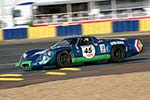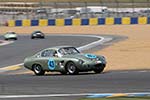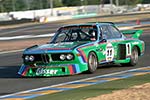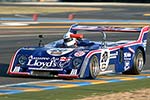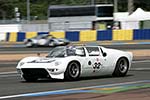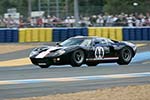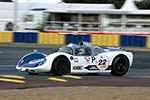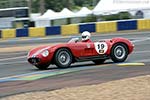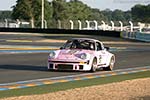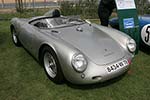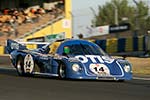
| Click here to save all images | Le Mans Classic |
| | 2002 | 2004 | 2006 | 2008 | 2010 | 2012 | 2014 | 2016 | 2018 | 2022 | 2023 | |
 Every even year the famous track in the La Sarthe district opens its full size to accommodate a host of historic racing cars, dating from the periods where the Mulsanne Straight was still straight. This year the event coincided with the Goodwood Festival of Speed, but that did not stop the traditional exodus from the British Isles. To avoid Paris during the rush hour, we took the western access roads to Le Mans via Rouen where we were joined by many classic motorcars, heading south. In spite of the torrential rains on Thursday afternoon many diehards refused to close their spiders and decided to sit it out. We noticed several caps on the motorway, so some heads must have gotten really wet.
Every even year the famous track in the La Sarthe district opens its full size to accommodate a host of historic racing cars, dating from the periods where the Mulsanne Straight was still straight. This year the event coincided with the Goodwood Festival of Speed, but that did not stop the traditional exodus from the British Isles. To avoid Paris during the rush hour, we took the western access roads to Le Mans via Rouen where we were joined by many classic motorcars, heading south. In spite of the torrential rains on Thursday afternoon many diehards refused to close their spiders and decided to sit it out. We noticed several caps on the motorway, so some heads must have gotten really wet. Fortunately Friday saw a daybreak that really looked more promising. Apart from some tiny specks of rain during the morning, the whole weekend was blessed with glorious weather. The relatively moderate temperatures may have helped to keep engine temperatures low enough during the struggle to move the cars from the paddocks to the assembly area.
So what was it all about? The system is quite simple. There are six grids, or �Plateaux� as the French call them, each containing 65 cars, all of them of models that once participated in the real thing. The idea is that there is racing for a period of 24 Hours, starting at 16.00 on Saturday afternoon, with a finish at Sunday afternoon at 16.00 hours. Each grid gets three racing sessions, each of 45 minutes, so in the end each car will have done 2 hours and 15 minutes of racing. Results are counted on aggregate. There are two practice sessions on Friday, one for the day and a second one until 02.00 in the morning top get used to the darkness.
In the end the winner of the pre-war class covered 21 racing laps, while the fastest cars from grid 5 and 6 managed 30 laps. Manning is allowed up to four drivers, but we saw cars run by a single driver and others by a complement of three. Many owners of historically important cars took the opportunity to share it with famous drivers from the past and even some contemporary hotshots from the endurance scene take a turn behind the wheel. The list is too long to name them all, but the French could cheer the likes of Henri Pescarolo (Rondeau), Gerard Larrousse (Lola T280), Jean Ragnotti (Alpine A443) and Rene Arnoux (Lola T70), while also Soheil Ayari found that a Porsche 917 is probably more difficult to keep on track than an Oreca-Courage. There was a happy return of Stephane Ortelli in the Freisinger Porsche 934, after his take-off in Monza. Peugeot Team Director Michel Barge and Stephane Sarrazin were to start in a Ford GT40, but unfortunately that car suffered problems early in the weekend. The two only Dutch Le Mans winners, Gijs van Lennep and Jan Lammers, took the wheel of two Porsche 550s,
Plateau 1 (Pre-War)
 A further aspect of the races involves car-hopping, whereby many drivers participate in different cars during the weekend, sometimes in cars starting in the same grid. This leads to such curious situations that overall victory in Grid 1 was heavily contested between Gareth Burnett and Julian Bronson in the Talbot 105 of John Ruston who had to fight a heroic battle with another Talbot 105, driven by Julian Bronson and Gareth Burnett. Burnett and Bronson duly won with almost 4 minutes advance.
A further aspect of the races involves car-hopping, whereby many drivers participate in different cars during the weekend, sometimes in cars starting in the same grid. This leads to such curious situations that overall victory in Grid 1 was heavily contested between Gareth Burnett and Julian Bronson in the Talbot 105 of John Ruston who had to fight a heroic battle with another Talbot 105, driven by Julian Bronson and Gareth Burnett. Burnett and Bronson duly won with almost 4 minutes advance.Another interesting car was the Riley MPH 2Litres, which was appropriately given starting Nr 1, as this car finished second overall in 1934 and first in class. Also present was the MG C type, that finished 6th overall in 1933 and the Delage D6-70 that came in 4th in 1937.
Bugattis and Bentleys further completed the field, with several nimble BMW 328s around as well some of the mighty Lagondas.
History repeated itself during the staged Le Mans start for this grid. While all reasonably senior drivers were running for their cars, Vanina Ickx trod in the footsteps of her father and walked calmly down to her BNC and drove off. Contrary to her father though, she did not go on to win the race.
Plateau 2 (1949-1956)
The cars to watch for in Grid 2 were the second finishing Rolt/Hamilton D Type from 1954 and the Talbot T26 GS, driven to second place in 1951 by Guy Mairesse and Pierre Meyrat. A replica of the aluminium bodied Porsche 356-1100 that won its class on its first official outing in 1951 was racing, while the original car was on show in the paddock.
Victory in class went to the Jaguar C-Type of Garry Pearson and owner Nigel Webb. This is the oldest existing C-Type, yet it is given as many outings as possible.
Plateau 3 (1957-1961)
 The outstanding car of this grid was the Aston Martin DBR1, winner overall in 1959. Its owner Harry Leventis does never hesitate to race this most valuable of all Astons on a very regular basis, helped by Peter Hardman and son Nick. This time their combined effort in the always immaculately prepared car resulted in 4th overall, behind the Gary Pearson/Nigel Webb driven D type, the incredibly fast and furiously driven Ferrari 250 SWB of Vincent Gaye and the Lotus 15 of the McIntyre family team.
The outstanding car of this grid was the Aston Martin DBR1, winner overall in 1959. Its owner Harry Leventis does never hesitate to race this most valuable of all Astons on a very regular basis, helped by Peter Hardman and son Nick. This time their combined effort in the always immaculately prepared car resulted in 4th overall, behind the Gary Pearson/Nigel Webb driven D type, the incredibly fast and furiously driven Ferrari 250 SWB of Vincent Gaye and the Lotus 15 of the McIntyre family team.The Aston�s sister car, 2nd overall in 1959, was an early victim and managed only 7 laps in total.
Plateau 4 (1962-1965)
1965 marked the last year of a Ferrari win at Le Mans and one example of the winning 250 LM was present, although not the actual winner. A very interesting entry was the ex Scuderia Filipinetti Porsche 904/6 that 11th overall in 1964. The car has recently been restored to racing conditions after a 30 year�s break. Another 904/6, entered by Klaus Frers came 4th overall in 1965 and again in 2008. The 9th finisher of that year, the Bizarrini Grifo was entered by Alberto Francioni.
The race itself was dominated by the Ford GT40s, unsuccessful in 1965 but now easily running away with the Christian Glasel driven car coming first and Richard Meins� car finishing second. Third was for the Tour Auto 2008 wining Cobra of Ludovic Caron.
 Plateau 5 (1966-1971)
Plateau 5 (1966-1971)During the event the question was raised what can be seen as the most iconic Le Mans car. The answer was predictable. A Gulf Porsche 917, as driven by Steve McQueen in the famous movie. There were of two of those, plus two others in other liveries. Against all history, it was however Olivier Cazalieres who drove his Ferrari 512S to a win, but with only 5 seconds advance on John Sheldon�s incredibly fast Chevron B16. Although Ayari in the 917 won the last race convincingly, his excursions in the field during an earlier race, saw him finish only 16th on aggregate.
The most famous car no doubt was Claude Nahum�s gold coloured Ford GT40 MKII, which came third in the staged 1966 finish with the two other Fords. This time the car finished a lowly 46th place, but it was certainly one of the outstanding cars of the weekend. Catching the eyes of many was also the 1966 Ferrari P3, owned and driven by the Leventis family.
Plateau 6 (1972-1979)
The car to beat here was Jean-Marc Luco�s Porsche 936, the same car that came 2nd in 1980 driven by Ickx and Joest. Needless to say, nobody was able to keep up with Luco who drove together with former Le Mans winner Jurgen Barth to three straight wins. Although much faster in practice, the Hadfield/Laidlaw/Schryver Lola T282 suffered a puncture in race one and a clutch problem in race 3 leaving it without any chance. However, Simon Hadfield proudly mentioned that very few people can claim to have reached pole in Monaco and LeMans during the same year.
 Conclusion
ConclusionAlthough in the 24 Hour race on its own is very much worth a visit, it is only part of the story. Many other aspects ensure that nobody gets bored during the weekend. Fifty children aged between 6 and 13 years participated on Saturday in the Little Big Mans race, using scaled down electric replicas of original cars, to cover one lap on the Bugatti circuit. And if you were tired of the races, the various parking areas were filled up with all sorts of exotic cars, brought from all over Europe. According to the organizers about 6000 cars were entered by the clubs, and looking at the oceans of Porsches, Alpines and Loti, they were probably right. The Le Mans village had the traditional small exhibition of famous Le Mans cars that were not on track, while Porsche, BMW and Mercedes also presented some racing history.
All in all this is a must visit event, as we already mentioned and fortunately we were not let down by the weather. We have captured the highlights, (admittedly not all of them) in a 140-shot slideshow.
Related Articles
|
|
|||||||||||||||||||
|
|
|||||||||||||||||||
|
|
|||||||||||||||||||
|
|
|||||||||||||||||||
|
|
|||||||||||||||||||
|
|
|||||||||||||||||||
|
|
|||||||||||||||||||
|
|
|||||||||||||||||||
|
||||||||||||||||||||
Report by Pieter Melissen and images by Sander van Dijk and Pieter Melissen for Ultimatecarpage.com.
| All Cars - Contact us - Privacy Statement - Top | © 1998 - 2024 Ultimatecarpage.com |


